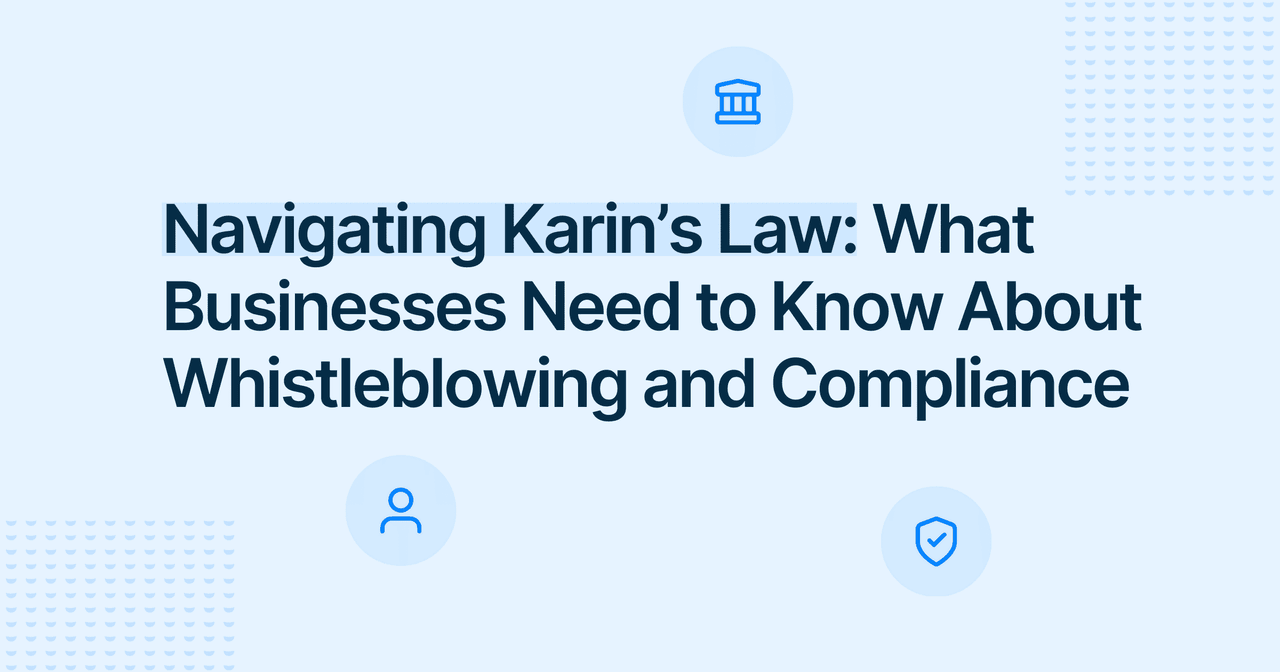




Whistleblowing

Alaa El-Shaarawi
Copywriter and Content Manager
Published
2025-11-04
Reading time
7 min


Table of contents
Subscribe to our newsletter
Let’s be honest, “whistleblowing governance” doesn’t exactly spark excitement. Most leaders hear it and think of policies, hotlines, and headaches. But the truth is, Australia’s whistleblowing landscape is shifting fast, and pretending it’s just another compliance box to tick could cost you.
In 2024, the rules got personal. Aged care reforms. The rise of the National Anti-Corruption Commission (NACC). Expanding whistleblower protections that reach beyond boardrooms and into nurses’ stations, contractors’ laptops, and family WhatsApp chats.
This isn’t just about paperwork. It’s about culture, credibility, and the courage to let people speak up safely. It’s a reminder that good corporate governance starts with trust.
Whistleblowing governance is how organisations make sure people who speak up are protected, and that what they say leads to action. It’s the framework that turns reporting from a risky move into a normal part of how good workplaces run.
In Australia, that responsibility doesn’t sit with one person. It’s shared.

A strong whistleblower policy shouldn’t just live in a handbook. It should live in how people behave; in how teams handle whistleblower complaints, prevent victimisation, and keep trust when things go wrong.
Whistleblowing platforms like FaceUp make this practical, giving organisations a simple, secure way to listen with clear reporting mechanisms, transparent escalation paths, and anonymous reporting options that show people it’s safe to come forward.
Because when reporting feels safe, culture changes. And that’s what governance is really about.
For sectors like aged care, these governance responsibilities are reinforced by new legal requirements that raise the bar on systems, protections, and reporting.
The new Aged Care Act 2024 flipped the script for providers. For years, “reporting issues” meant filling out an incident form. Now, it’s about running a whistleblowing system that actually works.
From 1 November 2025, every approved aged care provider must have:
If you’re still relying on a dusty PDF titled “Whistleblowing Policy 2019,” you’re already behind. The law no longer cares about good intentions. It cares about systems that protect real people.
Then there’s the National Anti-Corruption Commission (NACC), Australia’s new watchdog with serious teeth.
The NACC investigates serious or systemic corruption in the Commonwealth public sector. But here’s where things get messy: it overlaps with the Public Interest Disclosure Act (PID Act) and the Corporations Act, which cover different types of misconduct.
The result? Confusion. A lot of it.
“Do we report this to ASIC or the NACC?” “Is this corruption or just bad management?” “Are we even protected if we speak up?”
Too many organisations are stuck in that grey zone, afraid to move because the lines between “misconduct” and “corruption” blur with every reform.
But waiting for perfect clarity isn’t a strategy. You don’t need to understand every clause of every Act. You just need a whistleblowing system that catches red flags early and routes them to the right people, either internally or externally.
FaceUp gives compliance teams a single, transparent view of every disclosure, from the first report to resolution. No more guessing what’s been handled, ignored, or lost in someone’s inbox.
The biggest danger for most organisations right now isn’t corruption; it’s confusion. Here’s what’s tripping people up:
If that sounds familiar, you’re not alone. But regulators don’t accept “it’s complicated” as an excuse. When things go wrong, and they will, you’ll be judged not on what you meant to do, but on what you built to protect people who tried to do the right thing.
For a full breakdown of protections and obligations, see our Whistleblowing Legislation in Australia Guide.
So, how do you build a whistleblowing program that works in 2025 Australia? Not a box-ticking exercise, but a real mechanism that protects your people and your brand?
Here’s how to turn policies into systems that actually work:
Work out which regimes apply to you: Aged Care, Corporations, PID, NACC, or a mix.
Create a simple matrix:
It’s not glamorous work, but it’s the foundation of good governance.
Policies tell people what to do. Systems make sure they actually can. Set up:
Remember: the new Aged Care rules don’t ask if you have a “policy.” They ask if your system works. With FaceUp, organisations can create secure, accessible reporting forms tailored to different departments or risk areas, all feeding into one central case management dashboard.
Most people who blow the whistle don’t know they’re doing it. It’s the nurse who confides in her manager. The family member who mentions a concern over coffee. The contractor who sees dodgy paperwork. Train your teams to spot those moments and act. That’s where most compliance systems fail.
If your board still treats whistleblowing as “an HR issue,” you’ve got a governance problem.
Boards are expected to own ESG and corporate whistleblower oversight: to receive anonymised reports, monitor patterns, and make sure protections are real.
FaceUp’s analytics dashboards help stakeholders track themes, timelines, and outcomes, turning disclosures into data that informs better governance decisions.
This kind of oversight turns compliance into measurable accountability.
Let’s talk directly to aged care providers, because your sector is under the microscope.
The Aged Care Act 2024 is more than a regulatory update. It’s a cultural shift. The message is that residents and families deserve a voice, and providers must give them one.
You’ll need to handle disclosures that are emotional, messy, and sometimes deeply personal. That means training front-line staff in empathy as much as in procedure.
Because when someone says, “I think Mum isn’t getting her medication,” your response can define your organisation’s reputation more than any marketing campaign ever could.
If your staff don’t know how to handle that moment, or if your system buries it in bureaucracy, you’re not compliant. You’re complicit.

A good whistleblowing system doesn’t just protect you legally. It shows who you are.
Here’s the simple test:
Would your people actually use it?
If the answer’s “maybe,” you’ve still got work to do.
Culture is the hardest part, but it’s also where the biggest payoff lives. A team that trusts the system is a team that spots risks early, fixes problems fast, and keeps your organisation credible when it matters most.
While culture matters, governance does too. Track outcomes, follow up on reports, and make sure protections are real. That’s how trust becomes measurable.
Here’s your checklist for surviving and thriving in Australia's new governance landscape:
Whistleblowing isn’t about catching bad people. It’s about building good systems that protect your employees and your organisation. In 2025, that’s not optional. It’s the standard.
Compliance can be complicated, but protecting people shouldn’t be. FaceUp helps organisations in Australia simplify whistleblowing, stay compliant, and rebuild trust where it matters most. Book a free demo.





Keep Reading

Marie Roland2025-12-165 min
Whistleblowing

Alaa El-Shaarawi2025-12-087 min
Workplace Environment

Alaa El-Shaarawi2025-12-058 min
Legal & Compliance

Alaa El-Shaarawi2025-12-048 min
Legal & Compliance